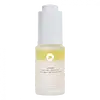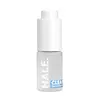What's inside
What's inside
 Key Ingredients
Key Ingredients

No key ingredients
 Benefits
Benefits

 Concerns
Concerns

No concerns
 Ingredients Side-by-side
Ingredients Side-by-side

Water
Skin ConditioningTriheptanoin
Skin ConditioningC13-15 Alkane
SolventButylene Glycol
HumectantSqualane
EmollientPropanediol
SolventDicaprylyl Ether
EmollientVaccinium Myrtillus Seed Oil
Skin Conditioning1,2-Hexanediol
Skin ConditioningCyclodextrin
AbsorbentLecithin
EmollientLysolecithin
EmulsifyingEuterpe Oleracea Fruit Extract
Caprylhydroxamic Acid
Ananas Sativus Fruit Extract
Skin ConditioningTranexamic Acid
Astringent3-O-Ethyl Ascorbic Acid
Skin ConditioningNiacinamide
SmoothingPotassium Azeloyl Diglycinate
Skin ConditioningPhenethyl Alcohol
MaskingBisabolol
MaskingTocopheryl Acetate
AntioxidantCaprylyl Glycol
EmollientPhytic Acid
Water, Triheptanoin, C13-15 Alkane, Butylene Glycol, Squalane, Propanediol, Dicaprylyl Ether, Vaccinium Myrtillus Seed Oil, 1,2-Hexanediol, Cyclodextrin, Lecithin, Lysolecithin, Euterpe Oleracea Fruit Extract, Caprylhydroxamic Acid, Ananas Sativus Fruit Extract, Tranexamic Acid, 3-O-Ethyl Ascorbic Acid, Niacinamide, Potassium Azeloyl Diglycinate, Phenethyl Alcohol, Bisabolol, Tocopheryl Acetate, Caprylyl Glycol, Phytic Acid
Ingredients Explained
These ingredients are found in both products.
Ingredients higher up in an ingredient list are typically present in a larger amount.
Caprylyl Glycol is a humectant and emollient, meaning it attracts and preserves moisture.
It is a common ingredient in many products, especially those designed to hydrate skin. The primary benefits are retaining moisture, skin softening, and promoting a healthy skin barrier.
Though Caprylyl Glycol is an alcohol derived from fatty acids, it is not the kind that can dry out skin.
This ingredient is also used as a preservative to extend the life of products. It has slight antimicrobial properties.
Learn more about Caprylyl GlycolSqualane is an emollient that helps the skin hold onto moisture. It's an oily liquid that occurs naturally in certain types of fish and plant oils.
Because squalane boosts hydration in the skin, it also comes with plenty of benefits: it is an antioxidant and can help fight free radicals and skin damage. Squalane is also found to have a detoxifying effect when applied.
Squalane comes from squalene, which occurs naturally within the sebum of our skin. It is one of the oils our skin produces to keep itself hydrated. Squalane is the hydrogenated version of squalene and has a longer shelf life.
Research shows that squalane is non-irritating (even at 100% concentration).
In general, it's a fantastic ingredient. It does a great job at hydrating the skin, and it's suitable for those with sensitive skin.
The source of squalane may impact malassezia / fungal acne. This is because olive oil derived squalane can contain impurities such as fatty acids and plant waxes. Sugarcane derived squalane is recommended for anyone with malassezia concerns.
Is squalane vegan?
This depends on the source. Squalane can be derived from both plants and animals. Most squalane used in skincare comes from plants.
Please note: the source of squalane is only known if disclosed by the brand. We recommend reaching out to the brand if you have any questions about their squalane.
Read more about squalene with an "e".
Is squalane an oil?
Squalane is often called an oil, but it’s technically not; it’s a hydrocarbon, meaning it’s only made of carbon and hydrogen, unlike true oils which are triglycerides made of fatty acids and glycerol.
The term “oil-free” isn’t regulated, so companies can define it however they want. Some exclude all oils, while others just avoid mineral oil or comedogenic oils.
While some people avoid oils thinking they cause breakouts, the right kind of oil (or oil-like ingredient like squalane) can actually help balance and hydrate your skin. It’s worth testing out simple oils or squalane to see what works best for your skin.
Learn more about Squalane